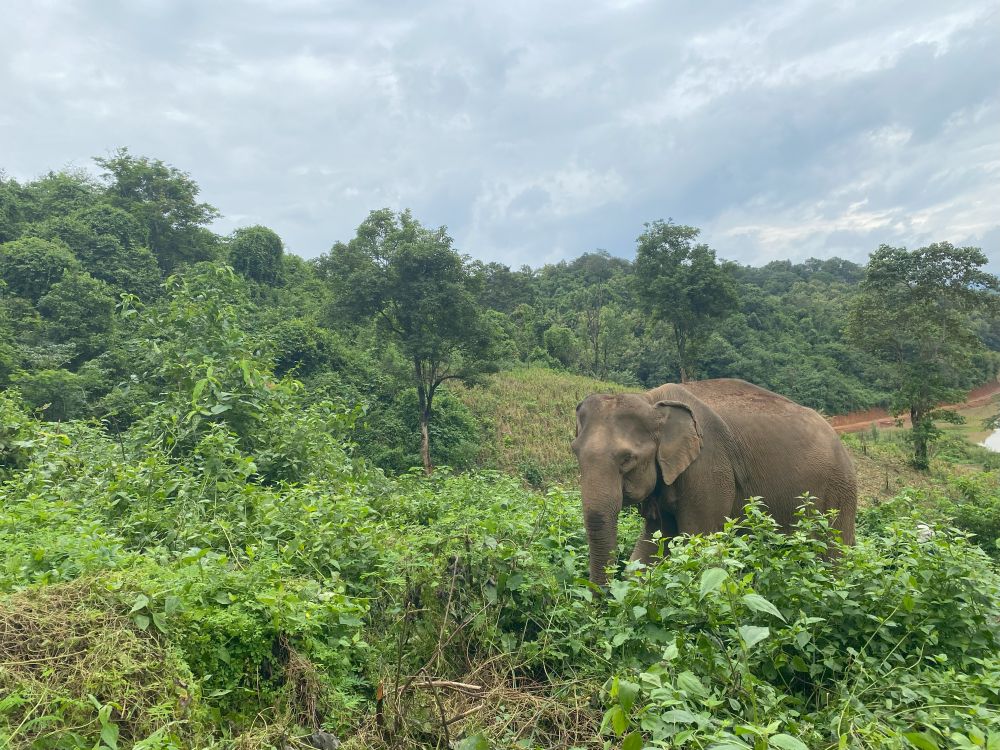
Three days at the Elephant Conservation Center in Sayaboury, Laos
The Elephant Conservation Center is a Lao-French joint venture established in 2010. They’re focus is on conservation of Asian elephants, particularly those in Laos, with an emphasis on breeding and re-wilding.
They currently have 34 resident elephants and 50 wild ones, on a 6,000 hectare section of National Protected Area in the north of Laos (and part of Thailand).
I spent three days at the Elephant Conservation Center in October 2023 and had an AMAZING time. This post is a write-up of my experience taking the 3 day, 2 night EXPLORATION package tour as a solo female traveler.
This post contains affiliate links. If you click on a link and buy something, I get a small percentage at no extra cost to you. Your support helps keep this blog running— thank you! Read full disclosure here.
Elephant Conservation Center Info
Most of the elephants in Laos were used for working, and so they never bred as they would’ve in the wild. Now there’s a big generation gap, as the former working elephants are either too old or too infertile to breed, and the younger ones are TOO young. Part of the ECC’s current focus is fixing that issue through their breeding program.
They also have a rewilding plan, where they help former domesticated elephants “rewild” themselves by forming family groups, and then releasing them into the national protected area. You can read more about that here.
Why go to the Elephant Conservation Center?
There are lots of elephant sanctuaries in Laos and Thailand, but ECC is different because guests have no interaction with the elephants at all.
You don’t touch the elephants. No bathing, no feeding. The only people who interact with the elephants directly are the mahouts and doctors.
This was VERY important to me, because touching/feeding/bathing/whatever is very disturbing to elephants. Just having that boundary set up showed me that the Elephant Conservation Center was truly ethical, and so I booked my tour with them.

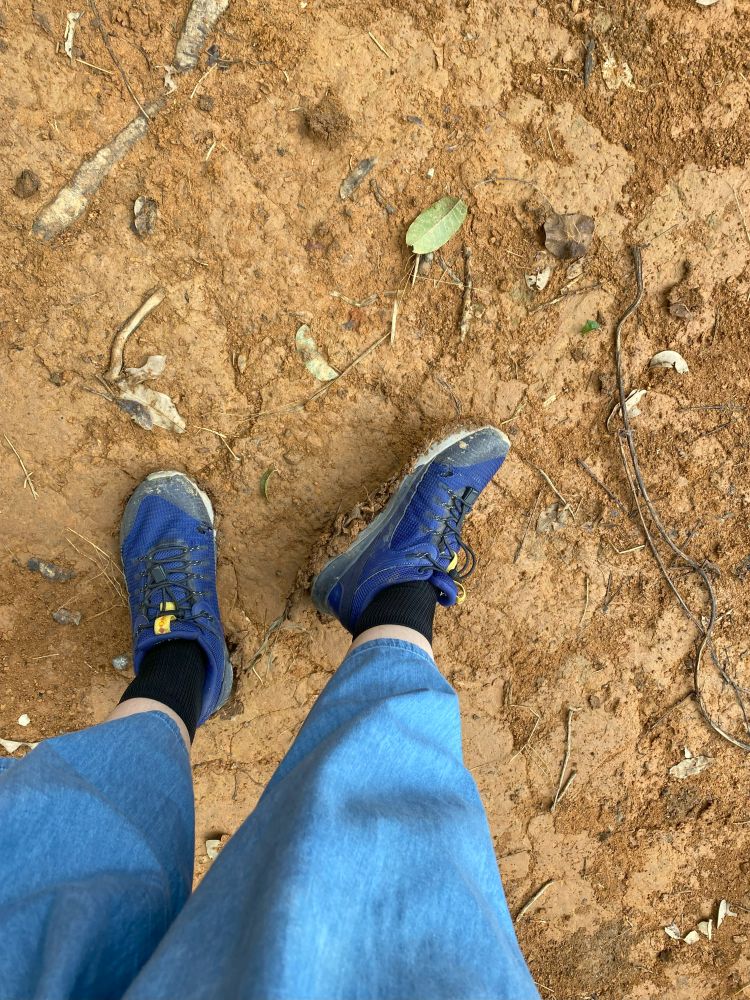
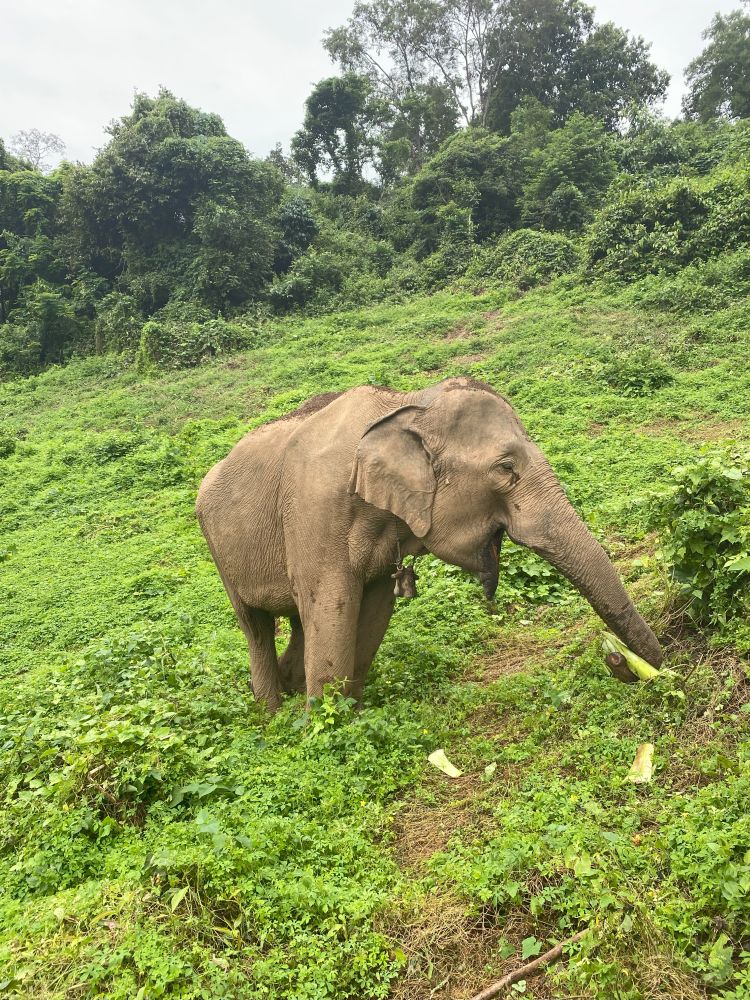

Elephant Conservation Center tour itinerary
They have a few different tour packages available. I booked a 3 day, 2 night package which included transportation to/from the Center, all meals, an English-speaking guide, and a private room with shared bathroom.
There’s also a 2 day, 1 night package for slightly less– but I have to say that everyone in our group who booked the smaller package wished they did the longer one!
Ready to book your Elephant Conservation Center tour? Check availability here at Klook!
Guests get to observe the elephants– sometimes from close up!– and learn about the history of elephants in Laos, as well as learn about the Center’s programs for breeding and re-wilding.
Day 1: Meet the elephants and Mahouts
Travel from Luang Prabang by minivan – Boat trip – Walk Through the Forest – Laotian Lunch – Nursery Visit – Hospital Visit – Observe Elephants Bathing – Encounter Elephants & Mahouts – Dinner.
Every group has an English-speaking guide who explains how the Center works, and how the Mahouts and the elephants work together. We saw important places in the Center, like the nursery, the hospital, the bathing area and the feeding area. In the evening, we “put the elephants to bed” e.g. followed the Mahouts out to the forest where the elephants go to sleep.
Day 2: Socialization Area
Breakfast – Meet the Elephants in the Forest – Observe Elephants Bathing – Socialization Area Observation – Lunch – Afternoon Bath – Positive Reinforcement Training – Vet Check – Dinner.
In the morning, after breakfast, we followed the Mahouts out to the forest and picked up an elephant from her sleeping spot. This was quite a tough hike because it’d been raining and the ground was SO muddy– of course, our Mahout was in flip flops and navigated the thick Laotian mud like a pro. 😉
This morning walk was super exciting for me because the elephant(s) got SO close to us! They were curious and wanted to see us a bit closer, but we didn’t interact or touch them– very important!
We then went to the Socialization Area, a huge (HUGE) forested area where the elephants come and meet up to play and look for food. We got to see young elephants interacting with their older aunties, which was super cute.
After lunch, the 2 day tour guests left to go back to Luang Prabang, and the 3 day tour guests continued their adventure. At the time, it was just me and one other person, so we basically had the run of the place.
In the afternoon, we went to the Hospital to see some training. Basically, the elephants need to be able to stay still and let vets give them shots or look at their feet, so they train them to be able to handle that interaction. It’s very gentle and the elephant gets treats afterward.
Dinner was exciting because a swarm of bugs started attacking the light above the table, dying, and then falling onto my plate.
Day 3: Bull elephants!
Breakfast – Male Elephants Socialization Area – Information Center – Lunch.
On the final day, we went to the bull elephant area. This was a short visit, where we sat in a tall observation tower with our guide and a mahout. We saw an older male elephant and a younger one interact with each other within a penned area.
It was interesting hearing about the different ways male elephants are socialized compared to female elephants, and how the ECC handles juvenile male elephants transitioning into adulthood. Basically, the younger ones learn male behavior from meeting older male elephants, but because males don’t hang out with the rest of the herd they have to “find” each other.
Finally, we had lunch and then drove back to Luang Prabang to get dropped off at the center of town.
Accommodation, food, and staff

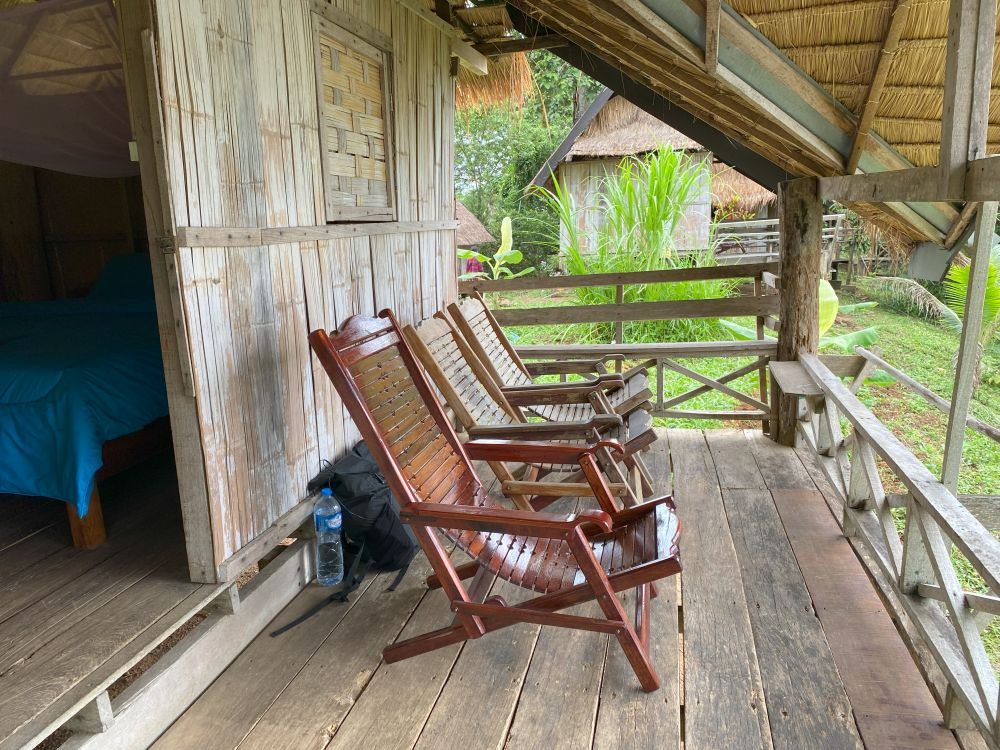


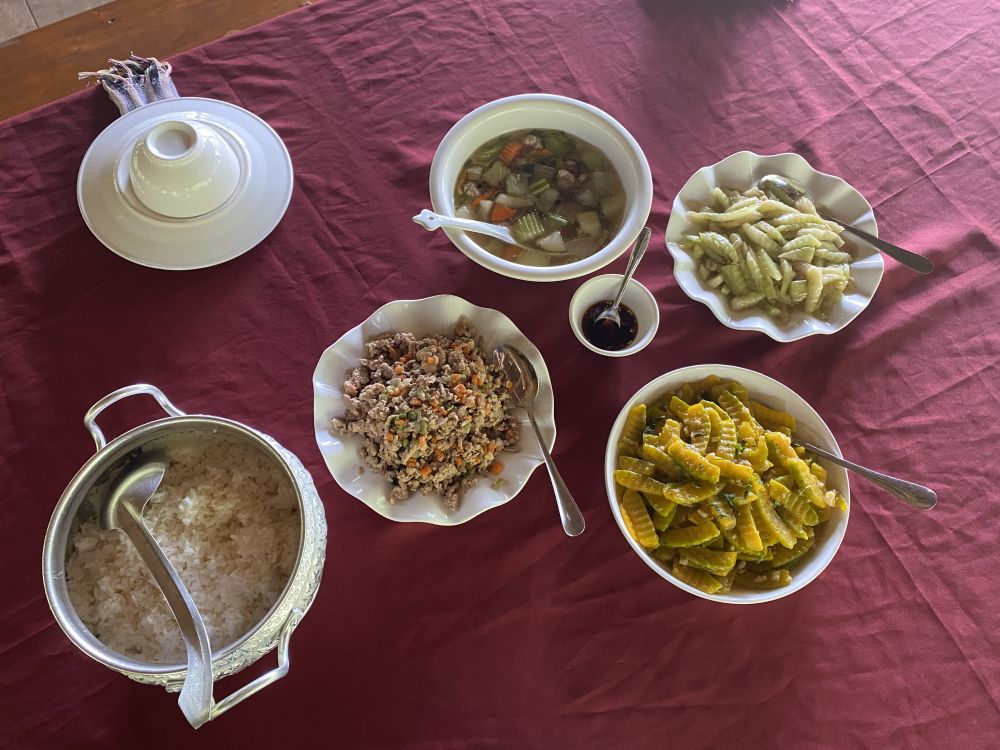
The accommodation choices range from basic (somewhat exposed-to-the-elements) to deluxe. I picked the cheapest cabin which was a big bed, mosquito net, a private porch looking onto the lake, electricity and fan. Toilets and showers were shared, like a hostel, and there was no wifi.
The deluxe cabins come with their own bathrooms and wifi, and the REALLY deluxe ones even have air con now! But honestly, it got cool enough at night that a fan was perfectly fine.
All the guests ate together in the dining hall, sometimes with staff!
Our meals were local recipes, but tempered to Western tastes. They can accommodate if you’re vegetarian, too. I found everything to be delicious and filling. Plus, they had French bread at breakfast! Yum!
The ECC staff and mahouts were all wonderful, very kind and willing to talk about the Center and their programs. The majority of the staff are locals, including the tour guides and mahouts, and they are paid wages. Some of the admin staff are volunteers from abroad (we met a French lady who had been volunteering there for years!) and they occasionally bring in outside help, usually for veterinary purposes.
As a bonus, there were four cats running around the dining hall during our stay! 😀
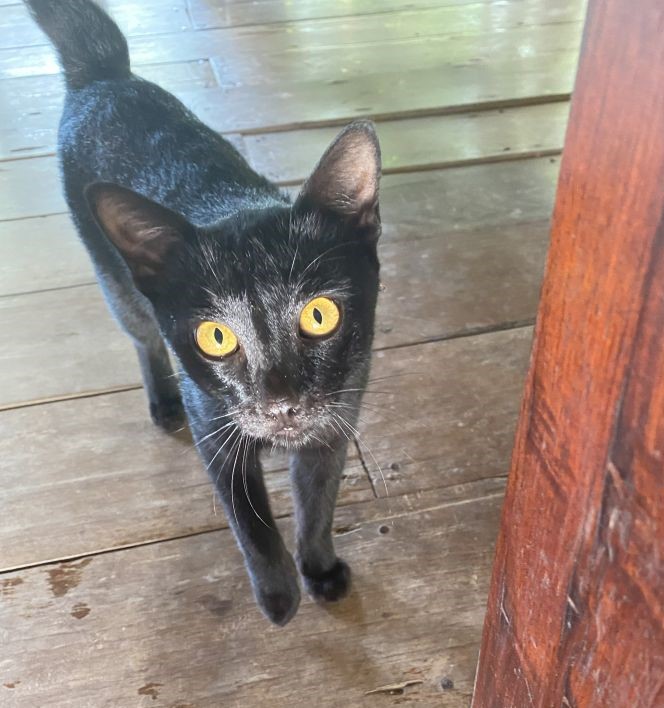

What to pack for an Elephant Conservation Center Tour
There are some specific things I’d recommend bringing with you to your Elephant Conservation Center tour:
- Hiking boots or trail runners. Some parts involve following elephants and mahouts out into wilder areas, and if it’s rainy season the trails will be muddy. A friend went in Tevas and got VERY dirty.
- Swimming stuff. Guests can go swimming or kayaking in the nearby lake!
- Mosquito spray. A LOT.
- Sunscreen, sunglasses, and a hat. Sun protection is important!
- Binoculars, to see elephants further away from the main trails.
I really enjoyed my stay and I highly recommend checking it out the Elephant Conservation Center if you’re staying in Luang Prabang or Sayaboury.
More Eco Tours in Laos
Looking for other amazing nature-heavy experiences? Check out these handpicked tours on Viator for some ideas on what’s possible in Laos!
Previous Entry
Asia 2023 Travel Diaries
Next Entry
Save on Pinterest


Explore More
More adventures in Laos:
- Taking the Laos Slow Boat to Luang Prabang (2023)
- Flying over Vang Vieng in a hot air balloon
- Visiting the Plain of Jars, Phonsavan, Laos
- Visiting Mulberries Organic Silk Farm in Phonsavan, Laos
- 10 fun things to do in Luang Prabang
Best Travel Resources
- 🛕Klook for tour discounts and attraction tickets
- 📱Airalo for eSIMs around the world
- 🛌Hostelworld for budget stays
- 🚙DiscoverCars for international car rentals
- 👩💻ExpressVPN to stay safe while browsing the web
- 🧑⚕️VisitorsCoverage for trip insurance



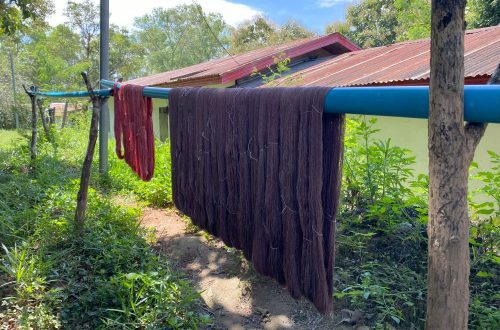

15 Comments
Christy S.
What an awesome bucket list travel experience. Love the tips and photos! I was about to ask about mosquitos and saw your advice about bringing bug spray.
Anastasia Finch
I think I blocked out how bad the mosquitos were in Laos because by that point in my trip I was being bit like every other day, but yes: bring bug spray! The local stuff, Soffell, works okay but it’s only about 13% DEET. If you want a higher percentage of DEET then bring a can of OFF or something with you before you get to Laos.
Caroline
Laos is undoubtedly my favourite country in South East Asia (says a lot because I am South east asian). I had visited an elephant sanctuary over a decade ago and I was never sure if it was a “good sanctuary” or simply a tourist attraction because people could touch the elephants etc. I know better now and I’m glad that the center in Sayaboury doesn’t allow any physical interactions with the elephants. This is such an amazing experience spending significant time with these animals. Thanks for sharing such a unique experience!
Anastasia Finch
It’s definitely a special place! Thanks for reading. 😀
Sonia
This looks like an incredible experience, and at a sanctuary that has a positive impact on the animals.
Anastasia Finch
It was super fun! They have a longer program where you can work as a volunteer, too.
ViewsArounsus
Very detailed Itinerary and it sounds really nice to have such places.
Anastasia Finch
It was one of my favorite experiences last year! High recommend it if you’re ever in Laos.
Melinda
I love that you found an ethical sanctuary. And good for you for being so blase about the exciting meal with bugs falling on your plate.
Anastasia Finch
Haha, thank you! That meal in particular was a bit of a struggle but it was the only time it happened, luckily. The staff eventually turned a fan on to blow over the table and divert the bugs a bit more, too.
Chelsea Messina
It’s nice to know they can accommodate vegetarians! Not all places do that, and it’s not easy to be a vegetarian in some countries. This is a fascinating article, how was it sleeping with the bug net? That would give me the creepy crawlies.
Anastasia Finch
I was worried about the bug net at first as I’d never slept under one before, but a staff member gave us a tip: stretch it out so it covers the whole bed, and then tuck the corners in UNDER the mattress. That way it stays off you at night and the bugs don’t find a gap to get through. It worked very well!
Marina
Wow! What an amazing adventure! Sounds so exciting and fun!
Sophie Lewis
Looks amazing and I am considering going here on my upcoming trip to Laos. i can see this is a recent blog- do the mahouts still ride the elephants? there are some photos on tripadvisor that suggests that they do but don’t know if they are outdated
Anastasia Finch
Hi! I didn’t see any mahouts actually ON the elephants during my time there, they just guided them from the ground.